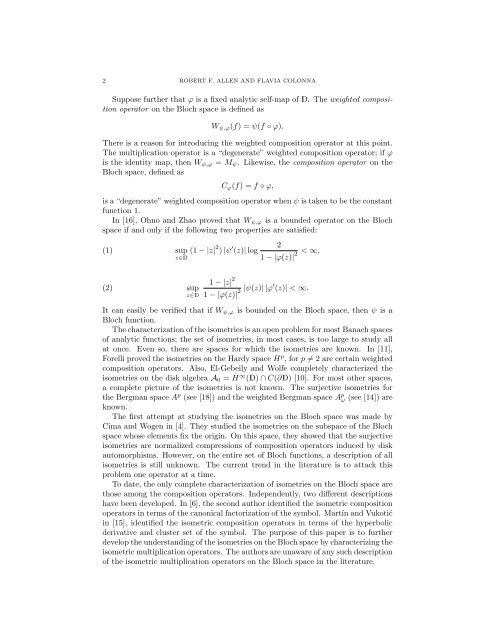Isometries and spectra of multiplication operators on the Bloch space
Isometries and spectra of multiplication operators on the Bloch space Isometries and spectra of multiplication operators on the Bloch space
2 ROBERT F. ALLEN AND FLAVIA COLONNA Suppose further that ϕ is a fixed analytic self-map
ISOMETRIC MULTIPLICATION OPERATORS 3 1.1. Organization
- Page 1: ISOMETRIES AND SPECTRA OF MULTIPLIC
- Page 5 and 6: ISOMETRIC MULTIPLICATION OPERATORS
- Page 7 and 8: So ISOMETRIC MULTIPLICATION OPERATO
- Page 9 and 10: ISOMETRIC MULTIPLICATION OPERATORS
- Page 11: ISOMETRIC MULTIPLICATION OPERATORS
2 ROBERT F. ALLEN AND FLAVIA COLONNA<br />
Suppose fur<strong>the</strong>r that ϕ is a fixed analytic self-map <str<strong>on</strong>g>of</str<strong>on</strong>g> D. The weighted compositi<strong>on</strong><br />
operator <strong>on</strong> <strong>the</strong> <strong>Bloch</strong> <strong>space</strong> is defined as<br />
Wψ,ϕ(f) = ψ(f ◦ ϕ).<br />
There is a reas<strong>on</strong> for introducing <strong>the</strong> weighted compositi<strong>on</strong> operator at this point.<br />
The <str<strong>on</strong>g>multiplicati<strong>on</strong></str<strong>on</strong>g> operator is a “degenerate” weighted compositi<strong>on</strong> operator; if ϕ<br />
is <strong>the</strong> identity map, <strong>the</strong>n Wψ,ϕ = Mψ. Likewise, <strong>the</strong> compositi<strong>on</strong> operator <strong>on</strong> <strong>the</strong><br />
<strong>Bloch</strong> <strong>space</strong>, defined as<br />
Cϕ(f) = f ◦ ϕ,<br />
is a “degenerate” weighted compositi<strong>on</strong> operator when ψ is taken to be <strong>the</strong> c<strong>on</strong>stant<br />
functi<strong>on</strong> 1.<br />
In [16], Ohno <str<strong>on</strong>g>and</str<strong>on</strong>g> Zhao proved that Wψ,ϕ is a bounded operator <strong>on</strong> <strong>the</strong> <strong>Bloch</strong><br />
<strong>space</strong> if <str<strong>on</strong>g>and</str<strong>on</strong>g> <strong>on</strong>ly if <strong>the</strong> following two properties are satisfied:<br />
(1) sup (1 − |z|<br />
z∈D<br />
2 ) |ψ ′ (z)| log<br />
(2) sup<br />
z∈D<br />
1 − |z| 2<br />
2<br />
2 < ∞,<br />
1 − |ϕ(z)|<br />
1 − |ϕ(z)| 2 |ψ(z)| |ϕ′ (z)| < ∞.<br />
It can easily be verified that if Wψ,ϕ is bounded <strong>on</strong> <strong>the</strong> <strong>Bloch</strong> <strong>space</strong>, <strong>the</strong>n ψ is a<br />
<strong>Bloch</strong> functi<strong>on</strong>.<br />
The characterizati<strong>on</strong> <str<strong>on</strong>g>of</str<strong>on</strong>g> <strong>the</strong> isometries is an open problem for most Banach <strong>space</strong>s<br />
<str<strong>on</strong>g>of</str<strong>on</strong>g> analytic functi<strong>on</strong>s; <strong>the</strong> set <str<strong>on</strong>g>of</str<strong>on</strong>g> isometries, in most cases, is too large to study all<br />
at <strong>on</strong>ce. Even so, <strong>the</strong>re are <strong>space</strong>s for which <strong>the</strong> isometries are known. In [11],<br />
Forelli proved <strong>the</strong> isometries <strong>on</strong> <strong>the</strong> Hardy <strong>space</strong> H p , for p = 2 are certain weighted<br />
compositi<strong>on</strong> <str<strong>on</strong>g>operators</str<strong>on</strong>g>. Also, El-Gebeily <str<strong>on</strong>g>and</str<strong>on</strong>g> Wolfe completely characterized <strong>the</strong><br />
isometries <strong>on</strong> <strong>the</strong> disk algebra A0 = H ∞ (D) ∩ C(∂D) [10]. For most o<strong>the</strong>r <strong>space</strong>s,<br />
a complete picture <str<strong>on</strong>g>of</str<strong>on</strong>g> <strong>the</strong> isometries is not known. The surjective isometries for<br />
<strong>the</strong> Bergman <strong>space</strong> A p (see [18]) <str<strong>on</strong>g>and</str<strong>on</strong>g> <strong>the</strong> weighted Bergman <strong>space</strong> A p ω (see [14]) are<br />
known.<br />
The first attempt at studying <strong>the</strong> isometries <strong>on</strong> <strong>the</strong> <strong>Bloch</strong> <strong>space</strong> was made by<br />
Cima <str<strong>on</strong>g>and</str<strong>on</strong>g> Wogen in [4]. They studied <strong>the</strong> isometries <strong>on</strong> <strong>the</strong> sub<strong>space</strong> <str<strong>on</strong>g>of</str<strong>on</strong>g> <strong>the</strong> <strong>Bloch</strong><br />
<strong>space</strong> whose elements fix <strong>the</strong> origin. On this <strong>space</strong>, <strong>the</strong>y showed that <strong>the</strong> surjective<br />
isometries are normalized compressi<strong>on</strong>s <str<strong>on</strong>g>of</str<strong>on</strong>g> compositi<strong>on</strong> <str<strong>on</strong>g>operators</str<strong>on</strong>g> induced by disk<br />
automorphisms. However, <strong>on</strong> <strong>the</strong> entire set <str<strong>on</strong>g>of</str<strong>on</strong>g> <strong>Bloch</strong> functi<strong>on</strong>s, a descripti<strong>on</strong> <str<strong>on</strong>g>of</str<strong>on</strong>g> all<br />
isometries is still unknown. The current trend in <strong>the</strong> literature is to attack this<br />
problem <strong>on</strong>e operator at a time.<br />
To date, <strong>the</strong> <strong>on</strong>ly complete characterizati<strong>on</strong> <str<strong>on</strong>g>of</str<strong>on</strong>g> isometries <strong>on</strong> <strong>the</strong> <strong>Bloch</strong> <strong>space</strong> are<br />
those am<strong>on</strong>g <strong>the</strong> compositi<strong>on</strong> <str<strong>on</strong>g>operators</str<strong>on</strong>g>. Independently, two different descripti<strong>on</strong>s<br />
have been developed. In [6], <strong>the</strong> sec<strong>on</strong>d author identified <strong>the</strong> isometric compositi<strong>on</strong><br />
<str<strong>on</strong>g>operators</str<strong>on</strong>g> in terms <str<strong>on</strong>g>of</str<strong>on</strong>g> <strong>the</strong> can<strong>on</strong>ical factorizati<strong>on</strong> <str<strong>on</strong>g>of</str<strong>on</strong>g> <strong>the</strong> symbol. Martín <str<strong>on</strong>g>and</str<strong>on</strong>g> Vukotić<br />
in [15], identified <strong>the</strong> isometric compositi<strong>on</strong> <str<strong>on</strong>g>operators</str<strong>on</strong>g> in terms <str<strong>on</strong>g>of</str<strong>on</strong>g> <strong>the</strong> hyperbolic<br />
derivative <str<strong>on</strong>g>and</str<strong>on</strong>g> cluster set <str<strong>on</strong>g>of</str<strong>on</strong>g> <strong>the</strong> symbol. The purpose <str<strong>on</strong>g>of</str<strong>on</strong>g> this paper is to fur<strong>the</strong>r<br />
develop <strong>the</strong> underst<str<strong>on</strong>g>and</str<strong>on</strong>g>ing <str<strong>on</strong>g>of</str<strong>on</strong>g> <strong>the</strong> isometries <strong>on</strong> <strong>the</strong> <strong>Bloch</strong> <strong>space</strong> by characterizing <strong>the</strong><br />
isometric <str<strong>on</strong>g>multiplicati<strong>on</strong></str<strong>on</strong>g> <str<strong>on</strong>g>operators</str<strong>on</strong>g>. The authors are unaware <str<strong>on</strong>g>of</str<strong>on</strong>g> any such descripti<strong>on</strong><br />
<str<strong>on</strong>g>of</str<strong>on</strong>g> <strong>the</strong> isometric <str<strong>on</strong>g>multiplicati<strong>on</strong></str<strong>on</strong>g> <str<strong>on</strong>g>operators</str<strong>on</strong>g> <strong>on</strong> <strong>the</strong> <strong>Bloch</strong> <strong>space</strong> in <strong>the</strong> literature.



